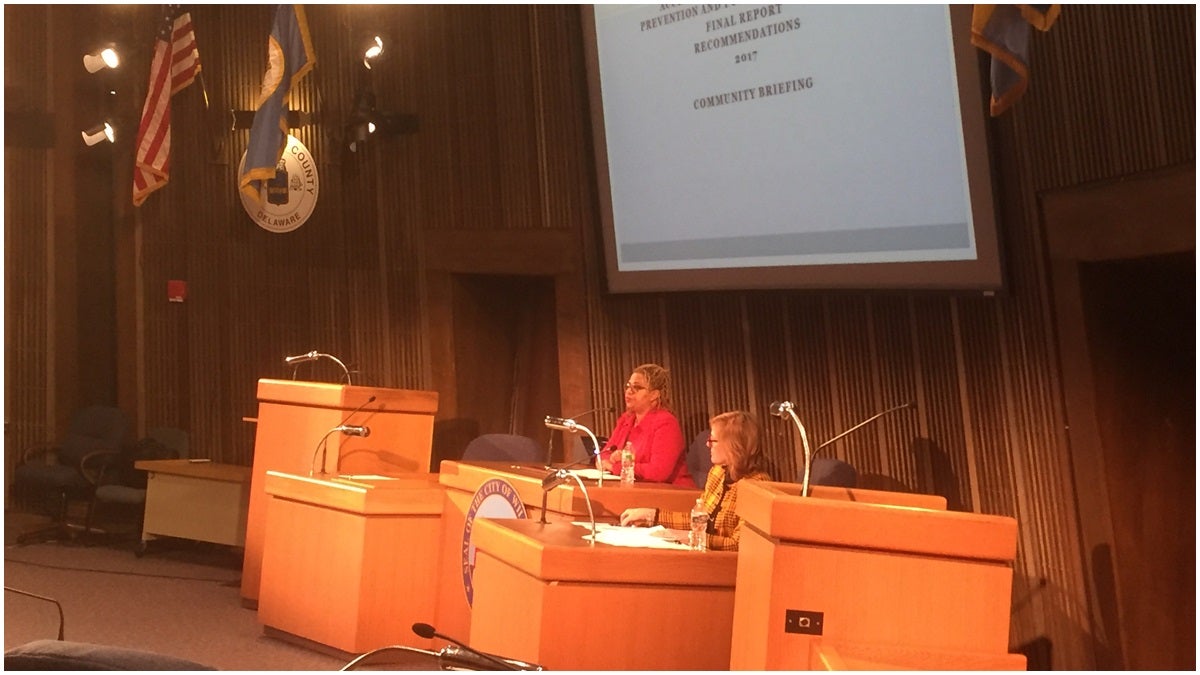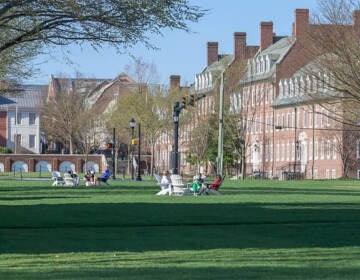Wilmington City Council releases recommendations to reduce violence

(Zoe Read/WHYY)
Recommendations to prevent gun violence in Wilmington through holistic services for youth were discussed during a public forum in City Council chambers Tuesday night.
City Council President Hanifa Shabazz, D-Wilmington, and former Department of Health Secretary Rita Landgraf announced the Center for Disease Control’s Community Advisory Council’s final recommendations for reducing Wilmington gun violence following 11 months of research.
“I think the most important thing is to get the support service programs out to the young people,” Shabazz said. “They need a major dose of it as soon as possible, so we can capture those in the pipeline that might be on their way to committing violence.”
Back in 2013, Shabazz proposed a resolution requesting the CDC investigate gun violence in the city.
Shabazz was instrumental in making the official request for CDC assistance in January 2014 during the administration of Mayor Dennis Williams, and the Division of Public Health formally requested the CDC’s assistance in June of that year.
The CDC study looked at medical, child welfare, criminal, employment and educational records from 2000 to 2014 to determine what factors make a person at-risk for committing a gun crime.
The results showed the majority of individuals involved in gun violence were young men with a history of poverty, abuse, family addiction, or a lack of education or employment.
Almost half of those involved in gun crimes were previously victims of crimes themselves, and 13 percent of those individuals visited an emergency room with a gunshot wound.
Following the report, the CDC recommended an increased collaboration between the various social services agencies to share data between each agency, and focusing the risk assessment on the youth population so they can experience lifelong benefits from prevention programs.
Finally, the CDC recommended the establishment of the Council to provide recommendations on evidence-based, wraparound services to provide to high-risk youth.
The Council includes 38 representatives form school districts, community based organizations, the faith community, the Division of Public Health, United Way, the Mayor’s office and City Council, as well as community advocates
On Tuesday, members of the public and City Council were invited to listen to the report and ask questions about the recommendations, which focus on establishing a holistic approach where service providers, schools and the state can work together to ensure youth are connected to the most effective resources.
“We are hitting this at multiple levels, with grassroots organizations, with our already engaged community providers,” Landgraf said. “We’re going to try to get a bigger impact, and almost triage, so those individuals that have a higher risk for vulnerability get the most support as they’re struggling with their own resiliency and the trauma that surrounds them relative to the violence.”
The Council focused its efforts on how to serve individuals between ages 4 and 24 who live in the highest need neighborhoods of Wilmington.
The group examined profiles of youth who live neighborhoods with the highest numbers of violence. Many of those individuals report witnessing violence in their communities, are on public assistance, receive social services, have been abused or neglected or have been expelled or dropped out of school.
The Council found that while there are programs in Wilmington that serve at risk youth, there aren’t enough of them and the services aren’t well-integrated—only 32 percent of youth who need support are receiving it. The group reports there needs to be more case management over a longer period of time for moderate and high risk youth.
The Council wants to expand capacity of youth programs and make them available seven days a week, and it also recommends a year-round employment program for youth.
The group also recommends the development of a screening process to identify moderate risk youth and refer them to services through a multi-tiered identification and referral system.
For high risk youth, the Council recommends increasing their level of support through individualized services with case management available to them as long as they need it. The group also suggests modeling a youth wellness center after the Hope Commission Achievement Center, which helps formerly incarcerated men reintegrate back into the community.
The Council also recommends the increase of outreach programs that are better aligned and integrated to engage more youth and families.
The group also plans to develop a pilot to integrate services by linking schools, community organizations, state agencies and health systems using a common platform for sharing student data and service information, and establish a school based coordinator to make connections to needed services.
Shabazz and Landgraf say the challenge will be sharing client information, which they say is crucial to identify high risk youth early, before they commit violence. The Council is working on a plan that will still protect privacy rights, modeling after a similar concept used in Pittsburgh.
In the next several weeks the Council will figure out how existing financial resources could be better leveraged to support pilot programs, implement those pilots and continue engaging with community stakeholders.
Programs already in existence will have to use the strategies recommended by the Council, which are data driven.
“We’re not reinventing the wheel, but we’re finding individuals who are doing bits and pieces of what needs to be done and we wanted to connect the dots with the service organizations, the after school programs, the community based organizations, the faith based entities,” Shabazz said. “How do we connect the dots that we’re all providing a net for our children to survive and no child falls between the cracks?”
The Council’s goal is to have two pilot programs running by the summer. Shabazz said she’s certain when the pilots prove successful they will be able to receive funding.
The recommendations have been presented to the Governor, Mayor and County Executive, and Shabazz says they’ll all on board. She said while it’s starting in Wilmington she hopes the recommendations will be enacted statewide.
“We’re going to spend money on youth programs anyway so why not use the money on youth programs we know is going to benefit the youth? Either we’re going to pay the money now or we’re going to pay the money later,” Shabazz said. “And with our economic condition in the city of Wilmington, if crime is a factor hindering our economic growth, then we have no choice but to address and spend money on the needs of our children so we can heal them and they can be prosperous contributors to society and add to the expanding work force.”
WHYY is your source for fact-based, in-depth journalism and information. As a nonprofit organization, we rely on financial support from readers like you. Please give today.





